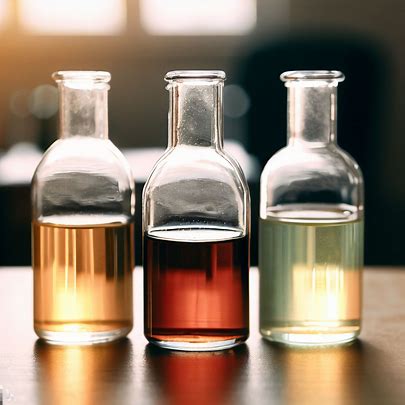I am the Head Formulator at MV Supplements, I earned my certificate in advanced hair formulations after 400 hours of sitting at my computer staring at a digital textbook and memorizing Cosmetic chemistry stabilization formulas and other useless crap.
Today we're diving in deep to science and studies to answer once and for all which Ru58841 solution is most effective.
Let's discuss these different RU58841 formulations popping up all over the place and let science answer which is best to prevent hair loss
How effective is a Pure Alcohol and RU58841 mixture? (Denatured Ethanol 96)

This is a 100% Ethanol Tincture for RU58841, which is eyebrow-raising to
anyone who knows anything about transdermal permeation. The human skin is our largest organ and is remarkable and has 3 layers, each of the 3 layers has dozens of its own layers with trillions of different cells that act as the bricks, mortar, and screws. Needless to say, our skin is very good at keeping foreign molecules it doesn't want out, which is why we need a co-solvent with enhanced dermal absorption in our RU58841 solution, like adding 30% Propylene Glycol
anyone who knows anything about transdermal permeation. The human skin is our largest organ and is remarkable and has 3 layers, each of the 3 layers has dozens of its own layers with trillions of different cells that act as the bricks, mortar, and screws. Needless to say, our skin is very good at keeping foreign molecules it doesn't want out, which is why we need a co-solvent with enhanced dermal absorption in our RU58841 solution, like adding 30% Propylene Glycol
Alcohol acts as an excellent solvent and preservative for many chemicals including RU58841 but there's one big problem....
It simply can not absorb RU58841 Molecular size into your Skin...not even close. Let's read a study from https://pubmed.ncbi.nlm.nih.gov/ Titled: "Effect of ethanol pretreatment on skin permeation of drugs"
A simplified version of the Study: "The Skin permeabilities of isosorbide mononitrate (ISMN) increased with Lower concentrations of Ethanol (EtOH), but decreased with Higher concentrations of Ethanol (EtOH). At 99.5% Ethanol (EtOH) the skin permeabilities of hydrophilic compound Isosorbide mononitrate (ISMN), decreased to non-detectable levels."
-
Clinical Study (shortened link): https://highlights.page/3pDh_
-
The RU58841 molecules can not fit through the pores of the skin with Pure Ethanol as the sole carrier.

Okay, so the Isosorbide mononitrate molecule couldn't absorb into the skin with a solution made of high concentrations of alcohol because its Molecular Mass of 191.139 g/mol is too large. The problem is RU58841 has a mass nearly 2x Larger with a Molar Mass of 369.3383 g/mol
-
So how much RU do you think will your skin absorb using a 100% Ethanol Solution? You'll get (as the study proves): half of the "undetectable levels" in your scalp, it does nothing...
The 70% Ethanol in our RU58841 solution serves 2 purposes and 2 purposes only, to dissolve and then preserve the stability of the Ru58841's shelflife,
So how much RU do you think will your skin absorb using a 100% Ethanol Solution? You'll get (as the study proves): half of the "undetectable levels" in your scalp, it does nothing...
The 70% Ethanol in our RU58841 solution serves 2 purposes and 2 purposes only, to dissolve and then preserve the stability of the Ru58841's shelflife,
-
The 30% propylene glycol in our solution gives it the amazing ability
to allow transdermal absorption of the hydrophobic molecule RU58841 to the deepest layer of skin where your hair follicle roots are located, in the hypodermis. Let's read another study from pubmed.ncbi.nlm.nih.gov/
to allow transdermal absorption of the hydrophobic molecule RU58841 to the deepest layer of skin where your hair follicle roots are located, in the hypodermis. Let's read another study from pubmed.ncbi.nlm.nih.gov/
A simplified version of the Clinical RU58841 Study linked below:

"PG has the ability as a co-solvent to enhance a drugs permeation through the skin, remarkably even if the drug itself has poor permeability the PG acting as a carrier will permit the now elastic chemical to squeeze themselves through the pores in the skin"
Clinical Study (shortened link): https://highlights.page/Jw_7w
-----------------------------------------------------------------------------------------------------------
K&B Emulsafier vs traditional Ethanthol + PG RU58841 solution

K&B Emulsafier RU58841 solution, at least this one has Some merit compared to the last one, but still not good and is more expensive. Let's see what Science has to say:
Propylene glycol (PG) and K&B can both be utilized as transdermal permeation enhancers in pharmaceutical preparations. While both compounds have demonstrated the ability to facilitate drug transport into the skin to some degree, propylene glycol is generally regarded as a more efficacious permeation enhancer than K&B, owing to several key factors.
Skin Irritation:
propylene glycol is an effective humectant, with the capacity to attract and retain water in your skin reducing irritation, which can augment skin hydration and Significantly elevates drug permeation into the scalp. PG has a PH (acidity level) of 10.5 the pH scale is logarithmic, not linear.
For example, a pH of 4 is ten times more acidic than a pH of 5 and 100 times more acidic than a pH of 6. A pure K&B emulsifier can be as acidic as 5.5 PH at pure concentrations this is tens of thousands of times more acidic than pure PG. Resulting in more likely for the general population to develop skin irritation with prolonged use, even in those who are not allergic. Additionally, K&B lacks such humectant properties as PG posses, K&B is primarily used as an emulsifying agent, which means it can disrupt the natural balance of the skin's oils and water content, leading to extreme dryness and irritation.
For example, a pH of 4 is ten times more acidic than a pH of 5 and 100 times more acidic than a pH of 6. A pure K&B emulsifier can be as acidic as 5.5 PH at pure concentrations this is tens of thousands of times more acidic than pure PG. Resulting in more likely for the general population to develop skin irritation with prolonged use, even in those who are not allergic. Additionally, K&B lacks such humectant properties as PG posses, K&B is primarily used as an emulsifying agent, which means it can disrupt the natural balance of the skin's oils and water content, leading to extreme dryness and irritation.
Effectiveness as a transdermal permeation enhancer K&B's potential for Skin Irritation...Again
propylene glycol has a very low molecular weight (76 g/mol), endowing it with a greater ability to traverse the skin barrier. In contrast, the Molecular size of K&B is a high molecular weight compound, which means it may not penetrate the skin as easily as PG, leading to the potential for accumulation and irritation at the skin surface
Thirdly, propylene glycol is Food-Grade and considered safe for application in pharmaceutical and cosmetic products, while the use of K&B may pose some safety concerns including difficulty breathing, chest tightness, and anaphylaxis.
In conclusion, propylene glycol inside a well-made RU58841 mixture is a more potent and safer transdermal permeation enhancer than K&B, owing to its superior solubility, humectant properties, lower molecular weight, price, and safety profile.
Thirdly, propylene glycol is Food-Grade and considered safe for application in pharmaceutical and cosmetic products, while the use of K&B may pose some safety concerns including difficulty breathing, chest tightness, and anaphylaxis.
In conclusion, propylene glycol inside a well-made RU58841 mixture is a more potent and safer transdermal permeation enhancer than K&B, owing to its superior solubility, humectant properties, lower molecular weight, price, and safety profile.
while both K&B and PG can potentially cause skin irritation, K&B is more likely to do so due to its larger molecular size, emulsifying properties, higher concentration in some products, and higher likelihood of triggering allergic reactions.
RU58841 Ethanol + PG solution can be purchased right here in Europe (Sweden) from a certified advanced hair formulator, MV Supplements a trusted name in the supplement / Research chemical and hair loss community.
-
--
---
-----
Too-Long-Didnt-Read
-----
a Pure Ethanol mixture of RU58841 is completely useless and can not physically penetrate the skin as the clinical studies proved above,
-
If you are one of the few who are physically allergic to PG then use K&B, Otherwise PG is a far more potent, tested, safer, and affordable transdermal permeation enhancer for your RU58841 solution. In my professional opinion, K&B is strictly a way for sellers to charge 5 extra dollars per bottle and make you believe you're getting a deal, PG causes no scalp irritation in 99% of people, millions of people including myself apply it daily. There is a reason 90% of RU58841 is still made with Ethanol + PG



Leave a comment
This site is protected by hCaptcha and the hCaptcha Privacy Policy and Terms of Service apply.